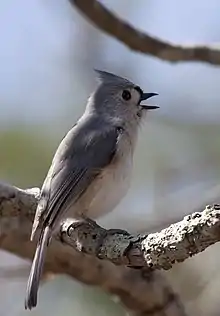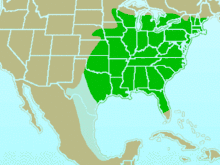Tufted titmouse
The tufted titmouse (Baeolophus bicolor) is a small songbird from North America, a species in the tit and chickadee family (Paridae). The black-crested titmouse, found from central and southern Texas southward,[2] was included as a subspecies, but now is considered a separate species, (Baeolophus atricristatus).[3]
| Tufted titmouse | |
|---|---|
 | |
| Adult singing | |
| Call | |
| Scientific classification | |
| Kingdom: | Animalia |
| Phylum: | Chordata |
| Class: | Aves |
| Order: | Passeriformes |
| Family: | Paridae |
| Genus: | Baeolophus |
| Species: | B. bicolor |
| Binomial name | |
| Baeolophus bicolor (Linnaeus, 1766) | |
 | |
| Range of tufted titmouse in green | |
| Synonyms | |
|
Parus bicolor Linnaeus, 1766 | |
Name
The genus name Baeolophus translates to small crested and is a compound of the Ancient Greek words βαιός : baiós - small, and λόφος : lόphοs - crest.
The species name bicolor means two-colored.
Description
Measurements:[4]
- Length: 5.5-6.3 in (14-16 cm)
- Weight: 0.6-0.9 oz (18-26 g)
- Wingspan: 7.9-10.2 in (20-26 cm)
These small birds are approximately six inches (15 cm) in length, with a white front, and grey upper body outlined with rust colored flanks. Other characteristics include their black foreheads, and the tufted grey crest on their heads.[5]
The song of the tufted titmouse is usually described as a whistled peter-peter-peter, although this song can vary in approximately 20 notable ways.[6]
Its habitat is deciduous and mixed woods as well as gardens, parks, and shrublands. Although the tufted titmouse is non-migratory and originally native to Ohio and Mississippi, factors such as bird feeders have caused these birds to occupy a larger amount of territory across the United States and stretching into Ontario, Canada.[5][7] From 1966 - 2015 the tufted titmouse population has increased by more than 1.5% per year throughout the northeastern U.S., Michigan, and Wisconsin.[8]
The tufted titmouse gathers food from the ground and from tree branches. It eats berries, nuts, insects, small fruit, snails, and seeds. Caterpillars constitute a major part of its diet during the summer. Titmice will stash food for later use.[9] The titmouse can demonstrate curiosity regarding humans, and sometimes will perch on a window ledge and seem to be peering into the house. It may cling to the windows and walls of buildings seeking prey in wasp and hornet nests. It is a regular visitor around bird feeders.[10] Its normal pattern is to scout a feeder from cover, fly in to take a seed, then fly back to cover to eat it.
Tufted titmice nest in a hole in a tree, either a natural cavity, a human-made nest box, or sometimes an old woodpecker nest.[11] They line the nest with soft materials, sometimes plucking hair from a live animal such as a dog.[12] If they find snake skin sheddings, they may incorporate pieces into their nest.[13] Eggs measure under 1 inch (2.5 centimetres) long and are white or cream-colored with brownish or purplish spots.[14]
The lifespan of the tufted titmouse is approximately 2.1 years, although it can live for more than ten years.[15] On average, these birds will have a clutch size of five to seven eggs.[16] Unlike many birds, the offspring of tufted titmice will often stay with their parents during the winter, and even after the first year of their life.[17] Sometimes, a bird born the year before will help its parents raise the next year's young.[18]
Gallery
.jpeg.webp) Tufted Titmouse (Tuftie) with a bit of snow on her beak.
Tufted Titmouse (Tuftie) with a bit of snow on her beak..jpg.webp) A Tufted Titmouse facing the photographer.
A Tufted Titmouse facing the photographer..jpg.webp) A Tufted Titmouse on a bird feeder.
A Tufted Titmouse on a bird feeder..jpeg.webp) Tufted Titmouse peeping at a White-breasted nuthatch.
Tufted Titmouse peeping at a White-breasted nuthatch..jpg.webp) Tufted Titmouse balancing on a peanut
Tufted Titmouse balancing on a peanut.jpg.webp) Tufted Titmouse on a branch
Tufted Titmouse on a branch
See also
References
- BirdLife International (2012). "Baeolophus bicolor". IUCN Red List of Threatened Species. 2012. Retrieved 26 November 2013.CS1 maint: ref=harv (link)
- Kaufman, Kenn (13 November 2014). "Black-crested Titmouse". National Audubon Society. Retrieved 13 October 2019.
- "Forty-Third Supplement to The American Ornithologists' Union Check-List of North American Birds". American Ornithological Society. 1 July 2002. Retrieved 13 October 2019.
- "Tufted Titmouse Identification, All About Birds, Cornell Lab of Ornithology". www.allaboutbirds.org. Retrieved 28 September 2020.
- McCommons, James (2003). "Tufted Titmouse". Emmaus. 50: 16. ProQuest 203733124.
- Grubb, Thomas C. (1998). Tufted Titmouse. Stackpole Books. ISBN 9780811729673.
- "Tufted Titmouse" (PDF). Ohio Birds. Retrieved 4 May 2018.
- "Tufted & Black-crest. Titmou Baeolophus bicolor / atricrista". Patuxent Wildlife Research Center. U.S. Geological Survey. Retrieved 2 January 2019.
- "Tufted Titmouse - Diet". National Audubon Society. 13 November 2014. Retrieved 13 October 2019.
- Montgomery, Sy. "Titmouse". Encyclopædia Britannica. Retrieved 13 October 2019.
- Laskey, Amelia. "Some Tufted Titmouse Life Historu" (PDF). Retrieved 4 May 2018.
- "Tufted Titmouse, Audubon Field Guide". 13 November 2014. Retrieved 17 August 2015.
- Medlin, Elizabeth C.; Risch, Thomas S. (2006). "An Experimental Test Of Snake Skin Use To Deter Nest Predation". The Condor. 108 (4): 963. doi:10.1650/0010-5422(2006)108[963:aetoss]2.0.co;2. ISSN 0010-5422. Lay summary.
- "Common Nesting birds - Tufted Titmouse (Baeolophus bicolor)". Nest Watch. Retrieved 13 October 2019.
- Elder, William H. (1985). "Survivorship in the Tufted Titmouse" (PDF). Wilson Bull. 97: 517–524 – via ProQuest.
- Laskey, Amelia R. (July 1957). "Some Tufted Titmouse Life History" (PDF). Bird Banding. 28 (3): 135–145. doi:10.2307/4510633. JSTOR 4510633 – via ProQuest.
- Pravosudova, Elena V.; Grubb, Thomas C.; Parker, Patricia G.; Doherty, Paul F. (1999). "Patch Size and Composition of Social Groups in Wintering Tufted Titmice". The Auk. 116 (4): 1152–1155. doi:10.2307/4089699. JSTOR 4089699.
- "All About Birds - Tufted Titmouse". Cornell Lab of Ornithology. Retrieved 13 October 2019.
External links
| Wikimedia Commons has media related to Tufted titmouse. |
| Wikispecies has information related to Baeolophus bicolor. |
- "Tufted titmouse media". Internet Bird Collection.
- Tufted titmouse species account – Cornell Lab of Ornithology
- Tufted titmouse – Baeolophus bicolor – USGS Patuxent Bird Identification InfoCenter
- Tufted titmouse photo gallery at VIREO (Drexel University)
